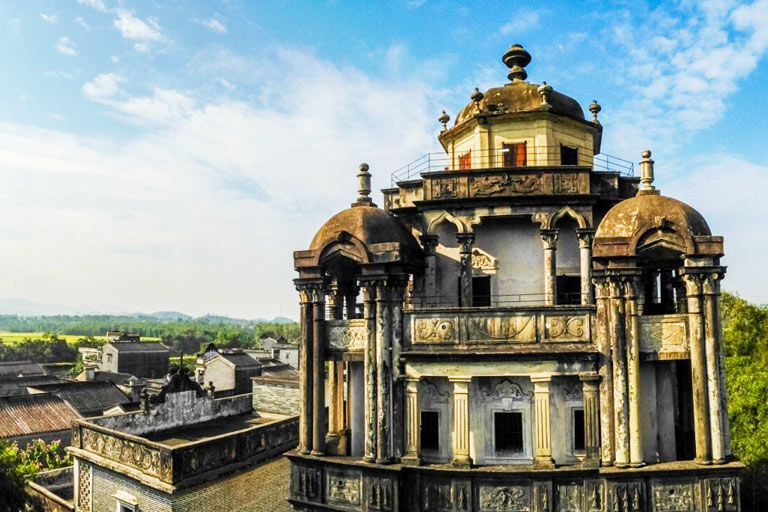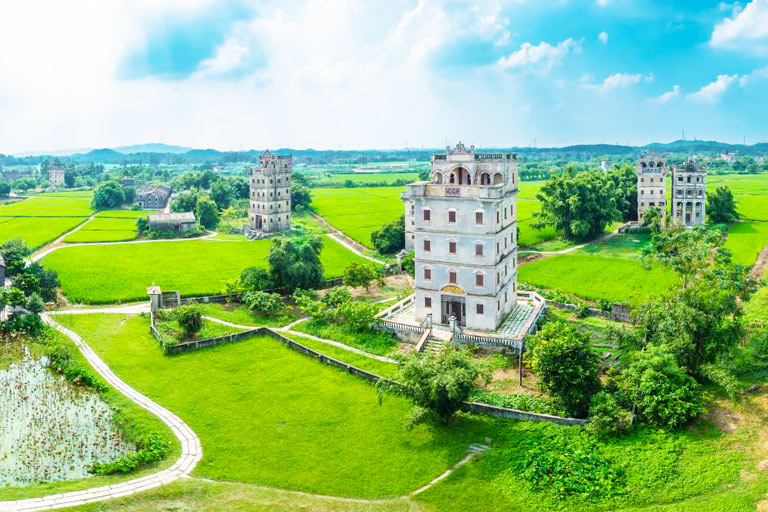Why Visit Kaiping Diaolou and Villages?
Kaiping Diaolou and Villages (开平碉楼), located in Kaiping (Hoi Ping), Jiangmen, Guangdong, China, has been collected in the 31st UNESCO World Cultural Heritage list since June, 2007, from which it became the first world heritage site about overseas Chinese in the whole China. Before that in 2006, it also has won the golden prize of the “Top 50 Places Worth-visiting In China for Foreigners”. These building clusters originally are a featured local Chinese type of buildings used for defending against bandits and escaping from frequent flood and typhoon, but as time goes by, they perfectly collect various typical architectural styles from many western places, including ancient Greece, ancient Rome, America, Canada, other European area, Islamic area, and so forth, which not only add more exotic beauty to this traditional village place in southern China, but also symbolizes the first positive accept of western culture of Chinese historically.
Furthermore, as the fruits of overseas Chinese who made a fortune and succeeded in south Asia, America in the middle 16th century, Kaiping Diaolou and Villages is the can’t-missing place to seek the background culture and history of overseas Chinese, learn the thriving of Guangdong people, and also discover the cultural communication of China with the foreign countries at those decades. You are extremely recommended to visit here to see the more than 1,800 watchtowers still remaining to feel the blending charm of various exotic arts of buildings and admire the lovely sceneries of local villages with rice fields, bridges, stream, pool, azure sky, etc.
Best Tour to Enjoy Kaiping Diaolou and Villagea:
>> 4 Days Kaiping Diaolou and Villages Admiration Tour with Guangzhou Bests
 Kaiping Diaolou and Villages - World Cultural Heritage
Kaiping Diaolou and Villages - World Cultural Heritage
 Zili Village Summer View
Zili Village Summer View
Why Kaiping Diaolou and Villages Were Built?
During 1366 - 1644 in Ming Dynasty, bandits were rampant around Kaiping with bad social order, and with the flood-prone disturb due to typhoon and heavy rains, local people lived without peace, so they had to build diaolou (碉楼), the watchtower, to have themselves protected. And in later centuries, local villagers built more and more solid diaolous, which successfully protected them from the robbers, bandits and floods.
Later during 1912 - 1926, there are several hijack incidents, and the searchlight on the diaolou of Yingcun Village found the bandit gang so that to save the school president and students. Such incident has made a stir in the whole county. Overseas Chinese found the diaolou really important to protect their family in China after heard the news, so they save money in foreign countries and brought their savings and fortunes back to Kaiping to build a wide array of diaolous in various styles and multiple exotic elements.
There were up to over 3,000 dialous in Kaiping at its peak period, and by far in 2007, there are 1,833 historical diaolous remain standing on the peaceful land villages in Kaiping, Jiangmen for your interesting understanding of the history and cultural change there.
Top Watchtowers to See in Kaiping Diaolou and Villages
More than 1,800 diaolous dot on the multiple natural villages in Kaiping City, and they are designed, built and decorated in diverse kinds of elements and styles from many countries and regions of the world, you can find dome of ancient roman style, roof of American castle, roof of European American villas, terrace of courtyard, etc., which is quite rarely seen in a traditional Chinese village region.
Zili Village
Zili Village (自力村) in Kaiping, was named from the hope of “live on the hump” or “self-dependence”. It is a must visit diaolou village in Kaiping as it is the special western castle village of featured Lingnan countryside flavor, and the poetic idyllic sightseeing of pool, lotus pond, rice fields and grassland present you a so beautiful visual gift to appreciate. Keeping 92 residences in total, there are 77 traditional folk houses, 9 diaolou buildings and 6 cottage-style villas.
Among all the buildings, Mingshi Building (铭石楼), the typical diaolou, was built by the overseas Chinese Runwen Fang (方润文) in 1925 AD after returning from Chicago, America. This 5-storey building covers 600 square meters and displays its beautiful outlook and luxury decorations, such as the Roman Ionic Order column, four-corners overhung on the “swallow’s nest”, pediment of Baroque style, Chinese styled hexagonal pavilion, green glazed tile roofs and arches, etc. Once you enter this building, the strong life atmosphere of overseas Chinese comes in front of you, with the well protected layout, living supplies of that time, such as imported floor clock, phonograph, censer, letters, foreign newspaper and magazine, overseas remittance documents, old pictures, etc. This “complete museum of overseas Chinese family” is surely recommended to feel the fast holing of traditional culture and the simultaneous pursuit of western culture of the host at that time.
Besides, you can get close to the cottage-style villas, such as Yesheng Mansion (叶生居庐), Lansheng Mansion (澜生居庐) and Guansheng Mansion (官生居庐) of the 3 sons of Yangxian Villa’s owner to imagine the past living scenes of Master living in the north building and servants working in the kitchen in the south annex building. Also, the traditional dwellings of Lingnan style focusing on the “three rooms and two corridors” can be appreciated in Zili Village to know the layout of the principal room where to receive guests, dine and worship ancestors, bedroom and kitchen.
As Zili Village puts emphasis on the protection and usage of water system and villagers develop their home based on natural environment, harmonious and idyllic countryside scenery is formed to draw the attention and favor of various visitors. Water surrounds the village, golden rape flowers boom in early spring, red and white lotuses dance in the pool under blue sky in summer months, bustling scene of harvesting lotus roots shows in late winter, continuous pieces of rice terraces change their colors according to different seasons, etc.
 Mingshi Builing at Zili Village
Mingshi Builing at Zili Village
 Inner Decoration of Mingshi Builing
Inner Decoration of Mingshi Builing
Li Garden
Li Garden (立园) or Liyuan Garden was built in early 20th century by the overseas Chinese Weili Xie (谢维立), based on the Daguan Garden (大观园) described in “A Dream in Red Mansions (红楼梦)” that is one of the Four Great Classical Novels in China. Besides, it skillfully combined the charm of classic garden in ancient China and contemporary popular characteristics of villas from Europe and America, which conveys a special beauty of architecture, and can be treated really excellent among private gardens built by overseas Chinese. In this exquisite lovely garden themed with “little bridge, stream and households”, gardens show within gardens, landscapes are found within landscape, which is intriguing to attract your deeper discovery. With the rich sculptures, frescos and more cultural calligraphic arts show everywhere, strolling in Li Garden is like relaxing in a wonderland.
The whole Li Garden mainly consists of three parts, namely the Grand Garden, Small Garden and villa clusters, separated respectively and connected harmoniously. Panli Building (泮立楼) was constructed in 1926, and this villa cluster was named after the owner Weili Xie and his father Shengpan Xie (谢圣泮). In this garden building, apparent ancient Chinese palace elements can be found from the exterior yellow walls and green tiles, overhanging eaves and bracket sets, and vivid carving arts from Chaozhou and plaster decoration of Lingnan features are outstanding to strengthen the local features of the diaolous. Apart from that, rich exotic charm exists there including American styled windows, ancient Roman columns, etc. All the inner decoration and amenities were brought from overseas to tell the achievement of the overseas Chinese host, such as Italian terrazzo floor, exquisite Oriental ceilings, silver western tableware, bathtub, etc. Moreover, roaming in the Grand Garden and Small Garden, you can find more surprises hidden in traditional Chinese class gardens and learn some interesting culture from Chinese poems and calligraphies.
 Classic Garden Pool at Li Garden
Classic Garden Pool at Li Garden
 Western Style Elements in Li Garden Diaolou
Western Style Elements in Li Garden Diaolou
Majianglong Village
Majianglong Village (马降龙村) or Maxianglong Village was built in early 20th century and mainly is the residence of Huang family and Guan family.
The whole Maxianglong Village leaning the mountain and facing the water, with the 7 diaolous and 8 cottage-style villas dotted among the ancient bamboos and forests, and the enchanting image of birds, flowers, plants, etc., this village is extremely appealing like a hidden fairyland. In there, you can visit the Junlu Cottage (骏庐) and Linlu Cottage (林庐), which were built by overseas Chinese Chongjun Guan (关崇骏) in 1936 after coming back from Canada. In Junlu Cottage, under the shrine that is used to worship their ancestors is designed in a pattern of a lion rolling the earth, which converges that the owner hoping all Chinese people thrive to develop widely among the world forest.
So why is it called Maxianglong Village? There in the east of the village is the Horse Mountain like a horse and another Baizu Mountain (Hundred-foot Mountain百足山) like a centipede behind the village. Local people believe hundred foot creature to be a dragon and a dragon brings wind and rains which is not good, so they hope the horse can subdue the dragon and bless them to be prosperous and rich always, therefore, local villagers gave the name of Ma Xiang Long to their village to mean the horse subduing the dragon.
 Domestic Animals at Majianglong Village
Domestic Animals at Majianglong Village
 Exotic Charming Buildings at Majianglong Village
Exotic Charming Buildings at Majianglong Village
What to Explore near Kaiping Diaolou and Villages?
Chikan Old Town
Chikan Old Town (赤坎古镇) is another place for a lot of overseas Chinese and their descendants nowadays to see the historical buildings. Built along Tanjiang River, the bank lined with pure arcade buildings of strong European styles is really attractive to admire the old track of Kaiping and Guangdong and learn the story of the families moving from other parts of China in the past time. And the South Tower (南楼) is a good place to know the heroic act of the 7 heroes of Situ family fighting with Japanese army and contributed their lives in 1945. You can get this town from Zili Village with only 10 minutes by car. Also, there are some buses available.
Besides that, you can also extend to appreciate more arcade constructions at Mei's Grand Courtyard where you can also feel the strong atmosphere in old Guangdong in 1930s.
 European Styled Chikan Old Town
European Styled Chikan Old Town
Recommended Traveling Routes to Visit Kaiping Diaolou and Villages
Since there are many watchtowers and villages in Kaiping, you may feel difficult to decide which one(s) to visit. For most travelers to Kaiping, we recommend you plan 1 day to visit Zili Village and Li Garden to see the best featured diaolous and countryside sceneries, which also spare enough time for your transfer from Guangzhou, Shenzhen and other nearby destinations in Guangdong. If you got more time, you can spend another day to enrich your discovery to Maxianglong Village, Chikan Old Town, and other nearby diaolou villages. For more traveling idea, please feel free to contact us!
>> 4 Days Kaiping Diaolou and Villages Admiration Tour with Guangzhou Bests
Map of Kaiping Diaolou and Villages & How to Get There
Kaiping Diaolou and Villages is situated in Kaiping City, Jiangmen City in Guangdong Province, which needs to drive about 18-20 kilometers (40 minutes) from Kaiping city downtown, about 70 kilometers (1.5-2 hours) from Jiangmen downtown, about 135-160 kilometers (2-2.5 hours) from Guangzhou downtown, and 215-220 kilometers (3.5 hours) from Shenzhen downtown.
People usually visit Kaiping Diaolou and Villages from other destinations in China, such as Guangzhou, Shenzhen, and Hong Kong, however, there is no directly transportation to the scenic area, so you need to get to Kaiping City first and transfer by hiring a local car or taxi. Local Kaiping buses are not really recommended since they will take more than 2 hours. I you go by bullet train, Kaiping South Station (开平南站) is preferred. If you arrive by coach, Kaiping Yici Station (开平义祠客运站) is recommended with shorter distance to the scenic area.
From Guangzhou
By high speed train
You can take a high speed train from Guangzhou South Station to Kaiping South Station for about 1 hour, and then you can hire a car to Kaiping Diaolou and Villages scenic area for another 40 minutes
By coach
Many coach stations in Guangzhou launce distance buses to Kaiping, like Guangdong Province Station, Fangcun Station, Tianhe Station, etc. the coach usually runs for about 2 hours. And after your arriving at Kaiping City, you need transfer by a local car a taxi to the scenic area.
From Shenzhen
Shenzhen has no high speed train to Kaiping so far. However, visitors can take a distance bus from Shenzhen Luohu Passenger Station Longgang Station for about 3.5 hours, and then transfer to the scenic spot by a local car or taxi.
From Hong Kong
Hong Kong Mong Kok, Tsim Sha Tsui, Causeway Bay, Disneyland, etc. have cross border buses to Kaiping, which take about 4-5.5 hours. You still need a further transfer by a local car.
Free Shuttle Bus between Kaiping Diaolou & Villages
There are free shuttle buses serving for your transfer among Zili Village, Li Garden and Majianglong Village every day. They depart nearly every 0.5-1.5 hours between 10:00-16:00 between Zili Village and Majianglong Village from Monday to Friday. And during weekends and holidays, they depart 0.5-1 hour between 09:30-16:00.
Kaiping Diaolou and Villages Opening Hours & Tickets
| Scenic Spot | Opening Hour | Building Closing Time | Closing Time | Tickets (CNY) |
|---|---|---|---|---|
| Li Garden | 08:40-17:45 | 17:30 | 19:00 | 100 |
| Zili Village | 08:40-17:40 | 17:25 | 78 | |
| Majianglong Village | 08:50-17:30 | 17:15 | 60 | |
| Jinjiangli | 09:00-17:15 | 17:00 | 50 | |
| South Tower (Chikan) | 08:30-17:45 | 17:30 | 5 | |
| Ticket Package (Li Garden, Zili Village, Majianglong Village, Jinjiangli and South Tower) | / | 180 | ||
| Zili Village + Li Garden | / | 150 | ||
Note: 1) ticket for single site is valid for that only 1 day, and ticket package is valid for 2 days. 2) the above information is for your reference only, for the detail fee and openining time information in Kaiping Diaolou and Villages, please contact our Travel Consultant!
Travel with China Discovery
To enjoy a worry free visit of Kaiping Diaolou and Villages and admire its best highlights, history and culture, you can choose to travel with us China Discovery. Our local guide and driver will escort you from your hotel / airport / train station to the scenic area directly with comfortable private vehicle with speed, so you can focus all your attention to what you are interested and have a relaxing trip to Kaiping. Furthermore, if you have any travel ideas or needs to visit more places in Guangzhou, Shenzhen, Hong Kong and other destinations in China such as Beijing, Shanghai, Guilin, Zhangjiajie, Chengdu, etc. you can feel free to tell us, and our professional travel expert will help you plan your trip in Guangdong and China or customize a trip for your based on your needs, interests and budget with their rich experience and professional knowledge!
Top Attractions in & around Guangzhou
- Chen Clan Ancestral Hall
- Temple of the Six Banyan Trees
- Yuexiu Park
- Canton Tower
- Sun Yat-sen Memorial Hall
- Nanyue King Mausuleum
- Kaiping Diaulou and Villages
- All Popular Guangzhou Tours
- How to Plan a Guangzhou Tour
- How to Get to & Around Guangzhou
- From Guangzhou Airport to Downtown
- Guangzhou Maps
- Guangzhou Metro
- Flights to Guangzhou
- Things to Do in Guangzhou
- Featured Activities in Guangzhou
- Top 6 Things to Do at Night
- Canton Fair (Import & Export Fair)
- Guangzhou Weather & Seasons
- Luxury Hotels in Guangzhou
- Comfortable Hotels in Guangzhou
- Where to Stay in Guangzhou
- 10 Best Cantonese Restaurants
- Top Food to Eat in Guangzhou
- All Guangzhou Travel Guide
Other Useful Travel Articles of Guangzhou
Recommended Guangzhou Tours
Top 3 Guangzhou tours chosen by most customers to explore Guangzhou in the best way. Check the detailed itinerary, or tailor your own trip now with us.

4 Days Kaiping Diaolou and Villages Admiration Tour with Guangzhou Bests
Guangzhou / Kaiping
Start planning your tailor-made holiday to China by contacting one of our specialists. Once inquired, you’ll get a response within 0.5~23.5 hours.
Customize a TripHave a question? Get answers from our travel experts or guests
- Your Question:
- Your Name:
- Your Email:
- Submit



















































